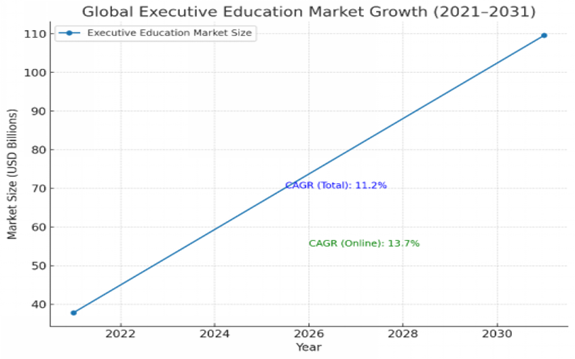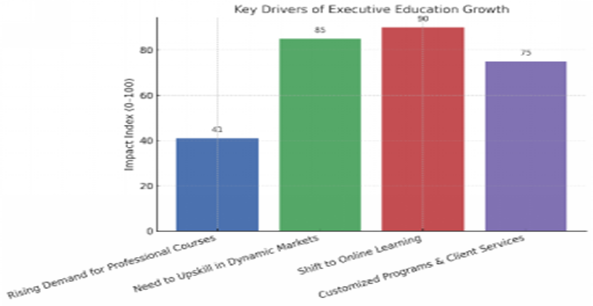
The VUCA world is driving corporations globally toascertain that the leadership pipeline is agile and resilient to route the vision through people, process, and technology consistently. Organisations are demonstrating consistent pursuit in developing the senior talent who drives through uncertainties and aligns analytical bent to draw and infer strategies for execution. Post pandemic, the market size for Executive Education and professional diploma programs has increased, thus combining accredited leadership training with measurable business outcomes is becoming far more significant. All such investments are drawn to unlearn and learn corporate strategies that focus on sustainable growth in a dynamic business environment. Thus, the question arises, does an organisation need to avail its Return on Investment (ROI) on any such Executive Education which was developed and executed for their senior leadership through online or onsite initiatives?
Executive Education programs are designed to strengthen leaders’ capability to deliver tangible organisational benefits, higher retention, improved productivity, and better alignment with strategic objectives. The empirical evidence from the literature supports the positive impact of employees’ educational attainments on their career outcomes. Research articulates that employees with advanced educational attainments exhibit fluid and crystallised cognitive abilities that allow them to excel (Ng and Feldman, 2009; Wang and Wanberg, 2017). Executive Education programs are experiencing dynamic growth, with the global market expected to increase from over $37.8 billion in 2021 to $109.6 billion in 2031, at a compounded annual growth rate (CAGR) of 11.2% as seen in the Figure. Online learning emerges as the most chosen medium, with a CAGR of 13.7% in 2031. (Future Market Insights, 2021; Los Angeles Business Journal, 2021).

The growth in demand for 41 professional courses and the prerequisite to up-skill professionals are the driving forces behind Executive Education’s popularity (Diaz & Halkias, 2021).

Executive Education has evolved dramatically, with new competitors rising, firms getting selective about corporate options, and more customized programs coupled with better client services (Stoten, 2023).
Companies worldwide invest an estimated $60 billion annually in leadership development initiatives, yet research highlights gaps:
This gap enunciates the need for programs that are accredited, structured, and outcome-focused. Executive Education is designed to address gaps by offering development that is strategically aligned and measurable in its impact.
Executive programs are aligned to meet immediate learning requirements. The VUCA and the Geopolitical pressure provide immense signals to leaders for a well-integrated Executive Education program that brings newness to People, Process & Technology in its usage. Bucketing organisational priorities under these headings will improve cross-functional collaboration, drive innovation, revenue execution, process change, and employee engagement holistically.
Executive Education ensures that, along with creative problem solving, it’s quintessential for executives to work on their core leadership skills in the changing dynamics of the workforce with Diversity, Equity, Belonging, and Inclusion (DEBI) context. A complete competency-based matrix supports assessing the current level and future potential of employees who wish to participate in Executive education. This highlights setting the tone for necessity and knowing the prerequisites before getting into an Executive Education program. Enunciating the benefits that will be accumulated for higher efficiency, growth, and productivity of the leading team and their leaders is the essence.
The employees undergoing Executive Education will have a framework to follow through the learnings drawn from the program and craft their Professional Development Personal Action Plans (PDPAP) used in the organisation. Their experiences will be channelised to reveal, reassure, and reinforce new learnings to step up the opportunity platform to excel. The test of ROI is whether learning translates into action. Executive programs encourage application through:
This ensures knowledge is embedded and leads to measurable change in the job for higher achievements and learning outcomes.
“What gets measured can be controlled.” Thus, organisations investing in Executive Education consistently report both quantitative and qualitative benefits. Enhanced financial performance is observed with improved levels of productivity within cross-functional teams, while integrating strategy and execution. Companies emphasising leadership development report significantly higher than their competitors, according to research.
A 20–30% lower turnover among high-potential employees is seen, recognising that their growth matters while strengthening loyalty. Organisations with robust leadership often achieve reduced recruitment and onboarding costs due to internal promotions.
Employees trained in these programs foster trust, collaboration, and purpose. Engaged employees become 21% more productive, according to Gallup research.
Overall, it’s necessary to measure investments in human capital development for the senior leadership team by having the indices to measure the ROI Framework.
Leadership and employee development are strategic investments. Executive Education programs align learning with business goals, deliver quantifiable outcomes and progress, benefiting employees, organisations, and maximising ROI. The result is stronger leadership talent, engaged employees, and long-term organisational success.As the need for skilled leaders grows, the question is no longer if organisations should invest in Executive Education, however, how soon they can begin.